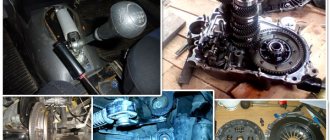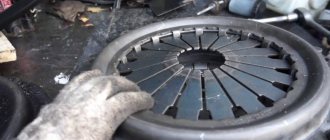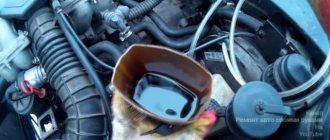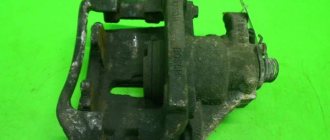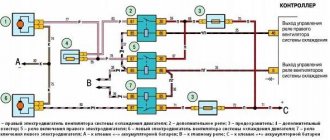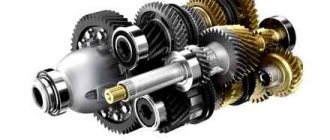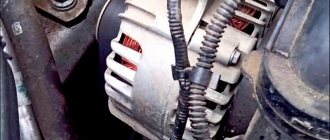Shifting gears in a manual transmission should be easy and quiet, regardless of whether the engine is running. In general, the engine is connected to the gearbox through a single unit - the clutch. It is with this that the difference in ease of switching is associated. There is one exception to this rule, which will be mentioned later.
Mechanism of interaction between the engine and the gearbox
The torque created by the car engine is removed and transmitted further from the flywheel. The flywheel is usually installed at the rear end of the crankshaft and is securely attached to it with several bolts. The bolts are equipped with special fixing belts in the threaded areas or are installed on an anaerobic retainer. Problems with fastening are extremely rare and are associated with gross mistakes by inattentive or unscrupulous servicemen.
The flywheel is a massive steel part with a machined end surface during manufacturing, along which the front friction lining of the clutch driven disc operates. When the clutch is engaged, the driven disk itself is tightly pressed to the flywheel by a powerful diaphragm spring of the drive disk. The spring, working surface and drive plate housing form the clutch basket. The basket is attached to the flywheel with several bolts around the perimeter of the casing.
The driven clutch disc is located between the flywheel and the drive disc, sometimes called the pressure disc. It consists of two friction linings, respectively to the flywheel and to the pressure plate, a damping device and a splined hub that slides freely along the splines of the gearbox input shaft.
When you press the pedal through a mechanical or hydraulic drive, the release bearing moves along the input shaft of the gearbox. The basket spring compresses and ceases to exert pressure on the driven disk. Zero force on the disc linings will result in zero friction between the flywheel and the linings. The primary shaft of the box, connected by splines to the disk hub, will stop its rotation. In such a situation, engaging a gear in the box is no different from the situation when the engine is not running.
The exception mentioned above is another connection between the engine and the gearbox. The front end of the input shaft rests on a bearing pressed into the end of the crankshaft. The friction in a working bearing is insignificant, and it is not able to spin the shaft when the working clutch is depressed. If rotation is difficult due to bearing wear, the shaft may continue to rotate, and the gearbox synchronizer will have to overcome the resulting parasitic torque with its internal friction. Shifting into gear will be difficult.
We recommend: How to choose tires for a car?
Difficulty shifting due to clutch fault
A sign of such a malfunction will be easy engagement of the gear when the engine is off and difficulty when trying to engage first or reverse gear with the car stationary with the engine running. Possible causes may be the following malfunctions.
- Incomplete clutch release due to problems with the drive. It is possible that the hydraulics may become airy, the mechanical drive adjustments may be disrupted, or the shape of parts may be distorted, for example, worn rods or a bent release bearing fork.
- Warping of the surfaces of friction pairs in the clutch. Happens when parts overheat. Both clutch discs and the flywheel can take on a wave-like shape. At the same time, it is not possible to completely retract the pressure plate; the clutch, as they say, “leads.”
- Exfoliated fibrous material from the linings got into the gaps between the driven disk and the driving surfaces.
- It is difficult to move the disk hub along the splines of the input shaft; the disk jams and continues to rub against the flywheel, although the force has already been removed from it.
- The clutch basket spring is deformed and the pressure plate operates skewed.
- The driven disk was stuck to the flywheel after the car had been parked for a long time.
Transmission problems
Ultimately, any malfunctions in the box lead to difficulties when switching. But this manifests itself already while the car is moving. That is, again with the engine running.
Most often the problem is caused by a faulty synchronizer. This simple device is designed, due to internal friction, to equalize the relative speeds of rotation of gears that engage in mesh. At the same time, due to the same friction, it wears out itself. It all ends with the fact that without grinding and great effort, it will not be possible to drive the gears into engagement. Treatment is to replace the synchronizer assembly. Together with the clutch and gear of a specific transmission.
There may also be problems with the switching mechanisms. For example, with forks. They rub along the annular grooves of the couplings and, despite the special very hard coating, also wear out over time. The transmissions first begin to fail, and then a complete failure occurs.
There are other causes of transmission strikes, but their occurrence can be delayed by the simple procedure of regular oil changes. You should not blindly believe the factory claims that oil is poured there for life. It may be so, but everyone will still want to extend this life. The oil ages and becomes dirty. By the end of its life, the cloudy slurry drained from there can hardly be called oil.
We recommend: Is it possible to flush the cooling system with Coca-Cola or citric acid?
Automatic boxes
As strange as it may sound, theoretically there are no fundamental differences between automatic transmission and manual transmission. Everywhere there are friction pairs (clutches or sets of wet discs), gear transmissions and an oil bath. Therefore, the diseases are the same, as are the measures for repair and prevention. There is no need to allow power slipping during sudden starts, skip oil changes and overheat the mechanisms. It’s just that this is even more relevant for automatic transmissions. The mechanisms here are more delicate, the oil requirements are high, and the cost of repairs is many times higher.
The situation is aggravated by the presence of complex hydraulic automation. Gear shifting here is controlled by a set of valves, which are vitally important to work with clean oil. What a manual transmission can tolerate, an automatic transmission will not tolerate. And instead of a clutch, a torque converter works here, which generates a lot of heat. The properties of the oil deteriorate sharply when heated. The presence of oil radiators does not always help. And to reassemble the box you will need a highly paid specialist with the required qualifications.
Problems with switching to automatic transmission
Shifting problems with automatic transmissions are not uncommon. Problems with the automatic machine arise for several reasons.
- backstage malfunction . This mechanism is the most problematic in old-type automatic transmissions. To eliminate the malfunction, the unit will need to be replaced. In most cases, it will be necessary to dismantle the gearbox for these purposes;
- insufficient oil level . The presence of lubricant leaks on the automatic transmission housing may indicate wear of the sealing gaskets, which are not difficult to replace yourself. After this, you need to change the oil in the box. Also, owners of cars with an automatic transmission are recommended to visually inspect the gearbox for oil leaks at least once every 2000 km;
- problems with the transmission control unit can ultimately cause the automatic transmission to completely lock up. To fix the problem, you will need to replace the failed mechanism and thoroughly inspect the electrical part of the gearbox.
Important! To solve problems with automatic transmission, it is recommended to conduct computer diagnostics of transmission faults.
How to properly adjust the rocker on a Priora?
This method is used, as a rule, when the first method did not produce results.
- Turn on first speed.
- Loosen the rocker
. - Turn the rocker
counterclockwise until the gearshift lever begins to rest against the plastic reverse speed stop. - Tighten the clamp and check how everything works.
Interesting materials:
How to disable screen lock on ZTE phone? How to disable the light sensor on your phone? How to turn off your home phone in Kyiv? How to turn off emergency calls on a Samsung phone? How to turn off emergency calls on your phone? How to disconnect a flash drive from your phone? How to disable Gmail on your phone? How to turn off voice guidance on an Honor phone? How to turn off voice search on your phone? How to disable voice mode on your phone?
Manual transmission: What you need to know when shifting gears
The result is premature wear of the clutch disc. In order to keep the car from rolling on an incline, you need to depress the brake pedal. In order to start, of course, you will have to press the clutch and smoothly press the gas, releasing the clutch. In this case, you will reduce the load time on the clutch basket and release bearing. You can also hold the car by maintaining certain engine speeds, catching a certain moment when you release the clutch and press the gas.
We recommend: How to make a heated steering wheel with your own hands?
Surprised? But in fact, this advice is really very important, because having a habit of leaving your hand on the gear shift knob can lead to premature transmission failure. If you most often leave your hand on the gearbox when stopped in a traffic jam or at a traffic light, then the first gear of the manual transmission suffers the most. Remember that by placing your hand on the gearshift knob, you create extra pressure on it, which is transferred to the gearbox. As a result, excess pressure on the handle can lead to unfree shifting of the desired gear. This can damage the gear shift knob as well as the transmission itself.
What to do if you have difficulty engaging reverse gear
If you have difficulty engaging reverse gear, you need to follow a certain algorithm of actions:
- If you feel that the gear has not reached the end, you need to release the clutch little by little.
- Fully depress the clutch and a few seconds later move the selector to the reverse position.
- Depress the clutch, set it to neutral and release it.
- Immediately after this, press the pedal and engage reverse gear.
You can also try to turn it on through another: for example, turn on the fourth, and then the rear one.
A transmission may shift poorly for a variety of reasons. You can determine the cause of the malfunction and eliminate it yourself, but it is better to contact a specialist. In the latter case, the risk of making a mistake is minimal.
For what reasons do interruptions occur?
There can be many reasons why gears do not shift when the engine is running. However, all of them, in one way or another, are connected with the two most important units of the car - the engine or gearbox. In case of serious damage, you should contact a good car service.
If the problem is in the gearbox, it will need to be removed for further disassembly and troubleshooting. If the problem is with engine components, they may need to be replaced. However, there are cases when, to eliminate a malfunction, it is enough to carry out preventive maintenance: removal, lubrication and careful adjustment of the components.
For those with automatic
If your car has an automatic transmission. It will not hurt you to know the modes in which your machine can operate:
- P – For parking and starting the engine. Switching to this mode is possible only after the machine has completely stopped.
- R – To move backwards. Switching to this mode is also possible only after stopping the car and with the brake pedal pressed.
- N – Neutral. When the engine is completely disconnected from the gearbox.
- D – Moving forward without restrictions on gear shifting (the most commonly used operating mode of the automatic transmission).
- D3(S) – Low gears for climbing and braking engines on descents.
- D2 – Mode for difficult conditions (slippery or mountainous roads). Gears above second are not shifted, that is, only first and second gears are engaged.
- D1(L) - Movement occurs only in 1st gear, used off-road on mud, snow or ice, where you need to drive without changing the throttle, and also to overcome steep climbs.
The automatic transmission also has a button on the mode shift lever with the inscription O/D OFF. When it is turned on, the inclusion is prohibited, increasing the gears of the analogue of the 5th gear of the manual transmission. That is, if your automatic machine has 4 gears for moving forward, then for more dynamic acceleration it will use only three lower gears.
About a faulty automatic transmission, an automatic transmission is much more complex than those encountered with a manual transmission, and the chances of repairing it in your garage are slim. But despite this, you still need to know something about it, if only in order not to harm it through improper use.
An automatic transmission is much more demanding in terms of accuracy in maintaining the oil level in it than a manual transmission. Both too low and too high oil levels are very harmful to her. Both of these can lead to serious damage. In both cases, oil foaming occurs. When there is a lack of oil due to the fact that the oil pump begins to capture air along with the oil. When there is excess oil, it foams on the rotating parts, which in this case are immersed in it. Foamed oil compresses better and has low thermal conductivity. Therefore, if you operate a machine with such oil, the pressure in its control systems will be low. Which will lead to slipping of the clutches and their intensive wear. Deteriorated thermal conductivity will not allow all excess heat to be removed. Which, together with low pressure, will lead to the machine failing and requiring serious repairs.
Foamed oil has more volume. Therefore, checking the oil will show the level is too high. If you find that the oil level has risen for no apparent reason, you need to turn off the engine and let the oil settle. After this, check the level again. If it turns out to be low, you need to safely add the required amount and repeat the test.
The oil level in the machine is checked using a dipstick or through a control hole closed with a plug.
How to check the oil level using a dipstick
- Warm up the oil to operating temperature (to do this you need to drive about 15 km).
Select a flat horizontal area for measurement. Put the car on the handbrake.
- Move the lever to select the operating mode of the box through all positions, holding in each position for 3 to 5 seconds, until the machine operates.
- Leave the mode selector in position P, and in this position determine the oil level.
- Without turning off the engine, remove the oil dipstick, wipe it dry and reinsert it into the tube until it stops, then pull it out and read the readings. The upper limit of oil traces on a dry dipstick should be at the mark with the inscription “hot” or in an area with intersecting notches.
If the level is insufficient, you can add oil through the tube into which the dipstick is inserted. Do not forget that the automatic transmission is afraid of dirt, so add only clean new oil. Wipe the dipstick with a clean cloth from which the threads do not fall out.
When checking the oil level, pay attention to its appearance. Dark liquid with a burning smell indicates that not everything is in order in the unit. First, try changing the oil and filter in the automatic transmission. The milky color of ATF indicates that coolant has entered the box. The coolant softens and swells the material from which the clutches are made. Do not hesitate to change such oil, having first eliminated the cause of antifreeze getting into the box, otherwise significant damage will be caused to the machine. Coolant may enter the box due to a leak in the oil section in the radiator of the cooling system. In this case, the emulsion will be observed both in the box and in the engine cooling system.
Why is it difficult for the gear lever to shift on a manual transmission?
- After the desired shift has occurred, you need to release the clutch pedal, there is no need to hold it! Because there is increased wear on the clutch disc
- It is advisable to move in the gear that corresponds to a given speed, this relieves both the engine and the gearbox from unnecessary loads, the best is 4th gear, also called “direct”, in this connection the minimum number of gears and all two shafts are occupied (in bypassing the intermediate). This reduces wear on the manual transmission
- A lower gear should be engaged when the speed decreases, just like an upshift when accelerating.
The main causes of malfunctions Mechanics, like automatic ones, are designed to transmit and change torque from the power unit to the wheels, and this must be done comfortably and dynamically. That is, the car must accelerate as quickly as possible and do this without any “jerks” of prohibitive engine speeds (so that it does not “growl like a victim”) and, if possible, have sufficient traction forces.
avtoexperts.ru
One of the malfunctions of a manual transmission is unclear gear shifting or the inability to engage them.
In such a situation, there may be several causes of the malfunction and it is necessary to immediately determine whether they relate to the gearbox itself or whether the problem is related to the clutch assembly. So, if all gears engage clearly when the engine is not running, and problems appear when the engine is running, then most likely the reason lies in the clutch.
In addition, the problem with switching gears can also be caused by a malfunction of the gear shift drive. In this case, the shift lever can be structurally located on the manual transmission itself (rear-wheel drive VAZ 2101-07 cars), or through a system of rods or cables from the scenes to the gearbox.
The very principle of operation of the transmission is the same for all brands of cars, regardless of whether it is a foreign car or a domestic car.
Manual transmission device
If you have any questions about turning on the gear, you don’t have to contact car service professionals; you can try to solve them yourself.
Let's look in order at what can influence poor speed activation or the impossibility of turning them on.
Rocker and gear shift rod
On front-wheel drive models, the linkage is connected to the manual transmission via rods, which, if faulty, may cause problems with shifting gears. Drive from the shift lever can also be used on rear-wheel drive models, for example, BMW 3, Moskvich 412 and others.
Backstage rods
There may be problems with the rocker such as loosening of its fastening or breaking of the shift knob. There may be malfunctions in the drive system such as loss of the traction lock, loosening of the gearbox drive slide.
Manual transmission link
To identify the malfunction, it is necessary to inspect the rocker in the car interior and inspect the drive under the bottom of the car.
On more modern models, the car is driven by a cable. If the cable breaks, gear shifting becomes impossible.
Ford Transit gear shift cable
Clutch drive
If the drive malfunctions, for example, a leaking hydraulic connection, incomplete squeezing occurs, which also leads to the fact that the gears are difficult to engage or will not engage.
Engine and gearbox mounts
If the power unit cushions are worn out, when they have sagged over time or burst, the rocker drive will work with distortion and it may break. Also, sagging cushions can cause jamming of the gearbox input shaft.
This is especially critical for rear-wheel drive cars, when the manual transmission mounting cushions sag, causing misalignment, which leads to difficulty or impossibility of switching gears.
Manual transmission cushion
Shift fork
The fork serves to transmit force from the clutch pedal to the clutch block through the release bearing. In cases where a crack forms at the fork, or it comes out of engagement with the release bearing, shifting gears becomes difficult or even impossible.
Faulty clutch fork
The plug needs to be inspected or replaced.
The release bearing is necessary to transfer force from the fork to the petals of the basket, which in turn moves the clutch disc away from the engine flywheel, breaking the torque (the motor operates separately from the transmission), making it possible to engage the required speed.
When the bearing wears out, the speeds will be difficult to switch on or switching will become impossible. The problem is solved by replacing the release bearing.
Collapsed release bearing
Basket
When the petals of the basket wear out or a crack appears in the petal disk, full squeezing does not occur; as a result, the driven disk does not completely move away from the engine flywheel, making it impossible to engage the gear.
Driven clutch disc
If the damping disk springs wear out or their fastenings are loosened, the gears will be difficult to engage and the power unit will shake. Also, when replacing a clutch disc, it is possible to install a product whose thickness is higher than the tolerance, which leads to the impossibility of completely disconnecting the disc from the flywheel, since there is not enough spring travel of the basket, which also leads to the impossibility of engaging gears.
Clutch disc
The problem is solved by replacing the disk.
Synchronizers
These elements are made of soft materials (copper, brass) and are therefore often subject to wear. Synchronizers especially suffer from sudden release of the clutch pedal during sudden starts, which leads to shock loads and rapid wear of the surface of the synchronizer cone or its breakage.
Gearbox synchronizer - yellow
If they wear out, switching will also be difficult or impossible.
Also, the inability to engage gears may be affected by wear of the gearbox shafts, when it will be impossible to engage second or fifth gears. This malfunction requires complete disassembly of the manual transmission and replacement of the shafts.
Gearbox shafts
Summary
If any manifestations of difficulty shifting gears appear, it is recommended to immediately identify the malfunction and take measures to eliminate it, since further operation of the manual transmission with a malfunction will ultimately result in complex and expensive transmission repairs.



